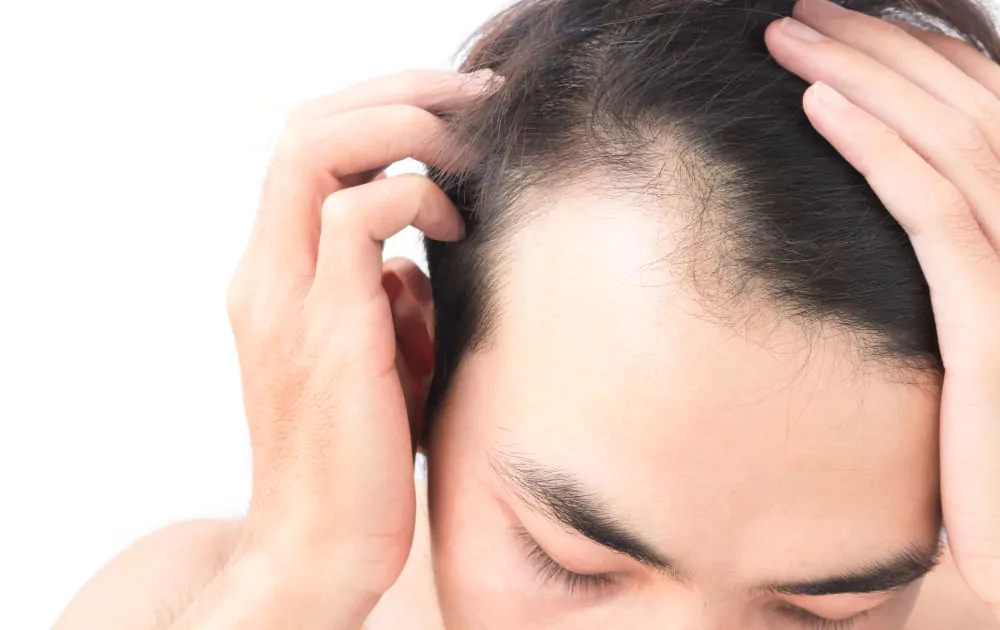Receding hairlines are more common than you might think, regardless of gender. Both men and women can experience thinning hair, hair loss, or a receding hairline as they age. Other factors also come into play, including disease.
While a receding hairline bothers some people more than others in terms of confidence and perceived self-image, it does not have to be permanent. Many promising treatments and therapies exist to keep receding hairlines at bay, including medically reviewed options. The sooner you act, the more likely you are to succeed.
Receding Hairline Stages

What is a receding hairline, and why does it often happen differently for women and men? Loss varies between genders and individuals, and male pattern hair loss tends to start around the temples and move around towards the back of the head. It can also leave a V-shaped or M-shaped growth pattern instead of receding evenly (for women as well).
Some receding hairlines accompany a bald spot that forms on the crown. Eventually, the receding hairline and the bald spot meet, which may result in total baldness. It can also leave a ring of hair below a bare (or mostly bare) scalp.
The process for women may happen slightly differently, but not always. Instead of starting at the hairline, the thinning process may begin at the natural parting instead and widen over time, resulting in visible bald spots. When combined with thinning around the temples, it can create the appearance of a receding hairline, as well.
Causes and Symptoms of Hair Loss
The symptoms of alopecia tend to be relatively static across the board. Most medically reviewed cases describe the following process:
- a receding hairline
- more of the hair falling out than usual
- thinner or weaker strands than before
- no new hair growth in places where it once grew
However, the causes of alopecia tend to vary far more across cases in men and women, including influences like genetics, age, and hormones.
Genetic History

A receding hairline and early hair thinning are strongly linked to family history. If your parents, grandparents, or any other blood relatives have experienced thinning hair or loss early in their lives, you are far more likely to face the same risk. However, if your relatives were fortunate enough to not experience much early hair loss, then your risk of developing the condition will correspond to that tendency.
One side of the family’s predisposition to hair loss may not be the only influence, and something like an immune disorder could also have the same effect. It may have been passed down in your family, and it can affect your prospects for healthy hair as much as genetics.
Age
One of the biggest contributors to further hair loss is age. Even in a family that doesn’t have much hair loss, most people’s locks naturally tend to become thinner or fall out more as they get older. The primary reason is that hair follicles become less effective over time, naturally growing back less vigorously in our later years.
Hormones
The most prominent contributors to natural hair loss conditions are hormonal, especially where there are drastic or unexpected changes in the hormone levels. These changes can happen to men and women as they age. It can also occur in the wake of medical issues and bodily changes, such as menopause.
Treatment Options

If you’ve noticed the onset of alopecia or know your family is predisposed to the condition, it is an excellent idea to explore treatment options, including medically reviewed ideas. The earlier you treat the hair loss, the better your chances will be of staving off the long-term effects. Read on to learn more about how to stop receding hairline with various therapies.
Stimulating Hair Growth and Hair Follicles with PRP (Platelet Rich Plasma)
PRP treatments are a relatively new way to treat hair loss with numerous other beneficial effects on the human body. In this procedure, a specialist will draw blood from your body, isolate the plasma, and inject it into the scalp to encourage new growth. The PRP treatment increases blood flow, helping to prevent further loss, revitalising the scalp tissue and hair follicles, and initiating the hair growth cycle.
Another form of PRP treatment is Factor4, which isolates specific growth factors and cytokines from your blood and plasma before the injection. Both Factor4 and our regular PRP treatments act as anti-aging and collagen-boosting treatments. It is excellent value for money and shows great results.
Essential Oils
Beneficial home-based remedies include essential oils, with many positive health effects in a variety of situations. For example, men and women can apply peppermint oil, lavender oil, and rosemary oil to the top of the head (in a carrier oil) to help stimulate regrowth in balding areas. You might consider coupling this with a scalp massage as an effective preventative measure that stimulates follicles in the process.
Laser Therapy
Modern lasers offer several uses in women’s and men’s health, but few people realise that lasers can also help to grow hair, not only to prevent its loss. One particular treatment is “low-level light therapy,” which is thought to send signals to the body’s cells and stimulate the growth of the hair follicles.
Hair Transplant
If you have a significantly receding hairline already, your best option might be to research a hair transplant procedure instead. A doctor will move strands from one area of the body to the hairline (usually from the back of your head). The transplanted hair is often permanent, but it is typically a costly and time-consuming surgery that has potential complications worth considering before you commit.
Hair transplants are popular, though. It is an effective treatment in the men’s health sector and an excellent long-term solution to existing baldness.
Preventative Measures That Help Fight Female and Male Pattern Baldness

Many of the preventative measures that help stave off the first signs of alopecia also serve as effective treatments for its effects. The same treatments one might use to reduce male pattern baldness may also work to keep it at bay, and much research goes into harnessing these effects.
Healthy Diet and Lifestyle
Nutritional imbalances often affect the way hair grows, including whether people have more hair or grow it thinly or unevenly. A full, thick head of hair tends to be a hallmark of a healthy individual, but it isn’t only down to diet—healthy habits count.
For example, bad habits change the way a person can shed hair, including:
- smoking,
- prescription drug abuse,
- excessive alcohol consumption,
- a lack of exercise, and
- medicinal side effects
While a human can lose dozens of strands daily, you should always consult with a healthcare professional or healthcare provider if the number of individual hairs you lose seems excessive. They can check for causes like an underlying medical condition and give you helpful guidance on how to proceed.
Hair Care
Unsurprisingly, the way you treat the follicles and scalp has a significant effect on their long-term health and the hairline. For example, many men with receding hairlines may decide that the best hairstyles are a buzz cut or clean shave. Long hair is a common choice in both men and women, but where there is evidence of loss, all people should avoid hairstyles that stress the scalp (particularly around the temples and the top of the head in tight ponytails, braids, and cornrows).
Some men prefer longer hairstyles, but it is much more common for women around the world. However, a short haircut is sometimes better for women who want to prevent the development of alopecia, especially if there is a history of it in the family.
FAQs
If you have any questions that we haven’t been able to answer in this article, you might find what you’re looking for in our frequently asked questions below.
Is hair loss preventable?
Preventing thinning or loss is not always possible, but treatments such as PRP and Factor4 may slow or stop the progression. If you already have quite an extensive receding hairline, you may be able to reverse it with PRP, transplants or other therapies that stimulate hair growth.
At what age can I expect hair loss?
Alopecia can happen at any time, but it is common sometime after puberty ends in men and women. The likelihood of loss rises with age, but it might also happen with disease or other conditions that are outside of that window. People younger than 17 years of age do not generally see this happening outside of those factors.
How can I encourage hair growth?
There are many things you can try at home to stimulate your hair follicle development and increase hair growth. If you would like to try some ideas, take a look at the “Treatment Options” section listed in this guide or contact our professionals.
If you are ready to receive one of our many effective treatments to address your receding hairline, please feel free to contact one of our Hair and Skin Science clinics today. We have offices in London for your convenience.




